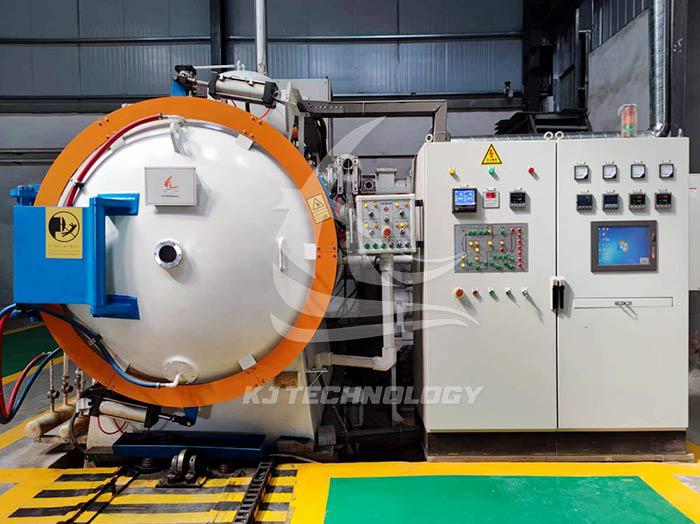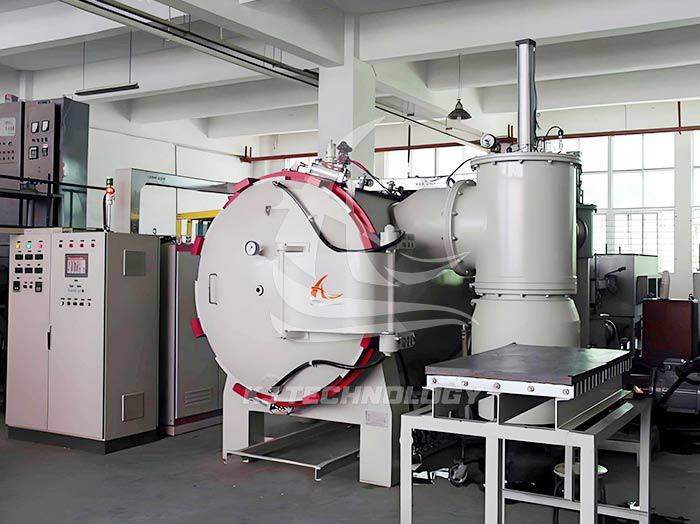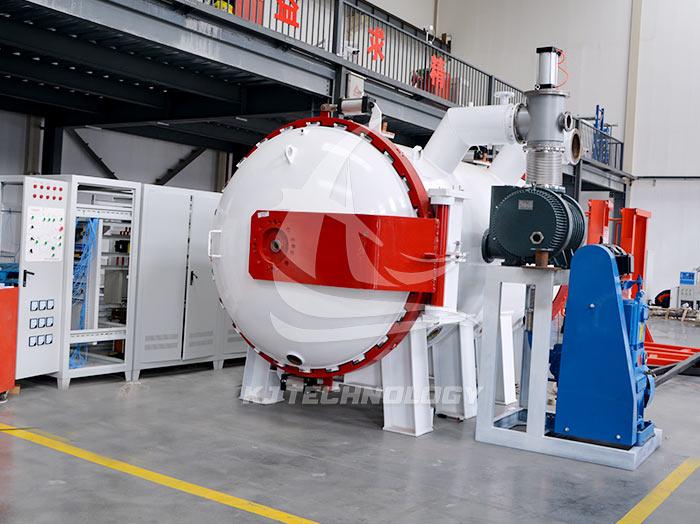High vacuum and high temperature brazing electric furnace
 08-26-2025 Author: KJ technology
08-26-2025 Author: KJ technology
High Vacuum and High Temperature Brazing Electric Furnace: Technical Analysis, Application Fields, and Precautions for Use
1. Core technology and performance indicators of equipment
Ultra high vacuum environment
The high vacuum high-temperature brazing electric furnace reduces the furnace pressure to 10 ⁻ Pa or even lower through a multi-stage vacuum pump system (mechanical pump, Roots pump, diffusion pump), and some equipment can achieve a maximum vacuum degree of 8.0 × 10 ⁻ Pa. This environment effectively suppresses metal oxidation, volatilization, and porosity, significantly improving the quality of welded joints, especially suitable for brazing easily oxidizable materials such as aluminum, titanium, and nickel based high-temperature alloys.
Accurate temperature control
The equipment is equipped with a high-precision temperature control system, with a temperature control accuracy of ± 1 ℃. It can be programmed to control hundreds of heat treatment curve points and supports independent temperature control in multiple areas (up, down, left, right, front, and rear six areas). Heating elements are usually made of molybdenum or tungsten wire, with a maximum heating temperature of up to 1500 ℃, meeting the welding requirements of special materials such as high-temperature alloys and ceramic metal composite materials.
Efficient gas circulation and cooling
The built-in gas circulation device can adjust the airflow velocity (0.5-2 m/s) to ensure temperature uniformity in the furnace (fluctuation within the constant temperature range of ≤± 5 ℃). The cooling system adopts forced water cooling method, with adjustable cooling speed (50-100 ℃/min), which shortens the production cycle and reduces the damage of thermal stress to the workpiece.
Safety and sealing design
The furnace body is made of high-quality stainless steel material, with an inner wall surface roughness Ra ≤ 0.8 μ m to reduce impurity adsorption. The vacuum sealing structure combines multi-layer rubber sealing and metal sealing to ensure long-term operational stability.
2. Typical application areas
aerospace
Key component manufacturing: Engine turbine blades, combustion chambers, heat exchangers, and other components that require extreme temperature and pressure, rely on vacuum brazing to achieve high-strength and airtight connections.
Material adaptability: Materials such as titanium alloys and nickel based high-temperature alloys can avoid oxidation in a vacuum environment, and the strength of welded joints is close to that of the base material.
automotive industry
Exhaust system: Components such as turbochargers and catalytic converters need to be resistant to high temperatures and corrosion. Vacuum brazing ensures that the welded joints are free of oxygen scale, thereby improving their service life.
Engine manufacturing: Complex structures such as cylinder blocks and cylinder heads are precisely connected through vacuum brazing, reducing the amount of mechanical processing required.
Electronic Packaging
High density packaging: Integrated circuits, power modules, etc. require ceramic metal and metal metal connections, vacuum brazing to avoid solder oxidation and improve electrical performance and reliability.
Microelectronic devices: Micro structures such as sensors and MEMS devices are connected with high precision through vacuum brazing, meeting the demand for miniaturization.
energy sector
Nuclear power equipment: components such as fuel rod cladding and heat exchangers need to operate in a strong radiation environment for a long time, and vacuum brazing provides defect free connections to ensure safety.
Solar collector: The connection between the heat absorbing tube and the reflector is achieved through vacuum brazing to achieve efficient heat conduction and improve heat collection efficiency.
medical device
Implant manufacturing: Precision connections of biocompatible materials (such as titanium alloys) are required for artificial joints, dental implants, etc. Vacuum brazing is used to avoid impurity contamination and meet medical standards.
Surgical instruments: High frequency electric knives, endoscopes, and other tools are connected with high strength and corrosion resistance through vacuum brazing, improving safety during use.
3. Precautions for use and maintenance points
Operating Specifications
Parameter setting: Overloading is strictly prohibited. The maximum operating temperature refers to the surface temperature of the heating element (usually 100 ℃ higher than the heated workpiece), and a reasonable heating curve should be set according to the material characteristics.
Material compatibility: Avoid direct contact between low melting point metals such as copper and aluminum and heating elements to prevent corrosion and component fracture.
Cleaning and maintenance: Clean the furnace oxide skin before daily use to prevent impurities from falling and causing short circuits; Regularly clean the bottom plate, insulation layer and other components, and strictly prohibit knocking to avoid melting and sparking of oxide skin.
safety protection
Grounding protection: The equipment casing must be reliably grounded to prevent leakage accidents.
Fire prevention measures: No fire in the workplace, equipped with fire extinguishers and set up waterproof areas.
Emergency response: If there is an alarm during equipment operation, the machine should be stopped immediately to troubleshoot; The power must be cut off during maintenance and repair.
maintenance cycle
Daily maintenance: clean the furnace, check the oil level of the vacuum pump, and confirm the sealing of the gas path.
Monthly maintenance: Check the resistance value of the heating element (replace if the deviation exceeds ± 20%), calibrate the temperature controller parameters.
Annual maintenance: replace sealing rings, check the flow rate of the water cooling system, and conduct comprehensive cleaning and anti-corrosion treatment on the furnace body.
4. Equipment selection suggestions
Select furnace capacity based on workpiece size: The common effective heating zone size is 600mm × 400mm × 300mm, and the operating space needs to be reserved according to the maximum outer diameter and length of the workpiece.
Select heating method based on material characteristics: materials such as high-temperature alloys and ceramics require high-power heating elements (such as tungsten wires), while materials such as aluminum and copper can be heated using molybdenum wires to reduce costs.
Configure auxiliary systems according to process requirements: if rapid cooling is required, a high flow forced water cooling system should be selected; If dealing with active metals such as titanium, a high-purity argon gas protection device is required.








